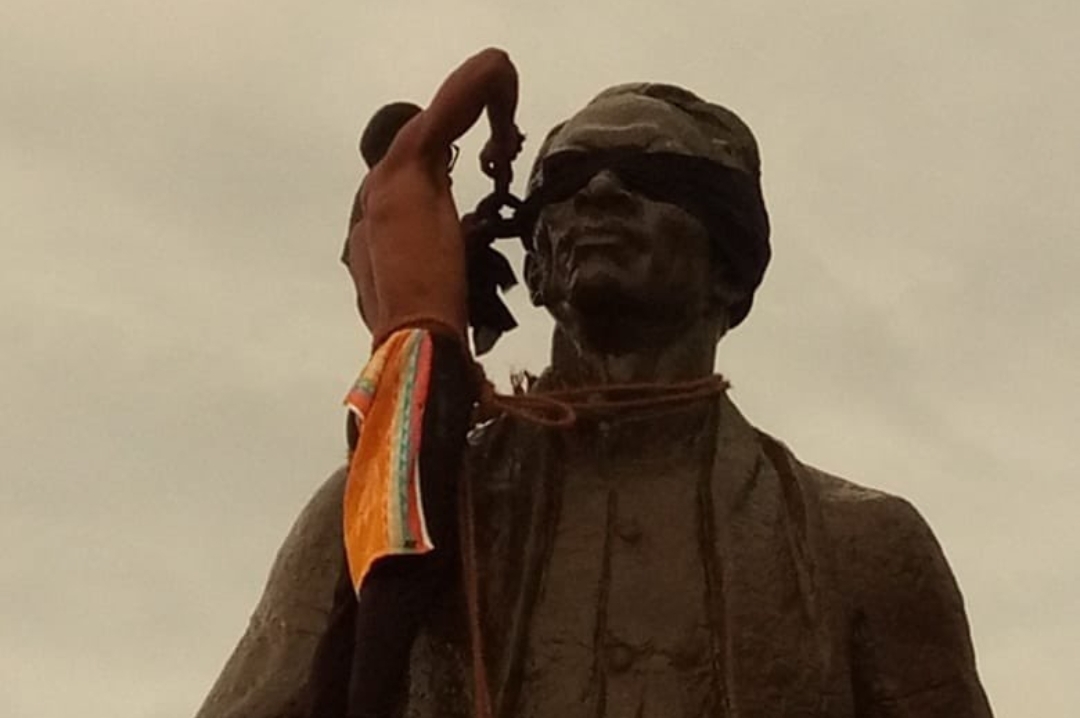
Factum Perspective: Blindfolding Bandaranaike: Revisiting the SLFP’s foreign policies
By Uditha Devapriya

The protests at Galle Face have been continuing for more than a month now. Initially aimed against Gotabaya Rajapaksa and his band of brothers, the infiltration of certain groups has diluted the tone and trajectory of the demonstrations. Over the last few weeks, the country has seen an unprecedented opening up of discussions. These discussions have centered on topics like sexual and minority rights, the abduction of journalists, and the need for a clearer foreign policy. Once considered taboo, they have led to heated debates outside and within the protests. One incident that has epitomized these developments is the blindfolding of the statue of S. W. R. D. Bandaranaike, just opposite Shangri-La Hotel.
For mainstream scholars and popular writers, the ethnic crisis in Sri Lanka – a crisis that long predates the Rajapaksas – can be traced back to the enactment of Sinhala Only. While it’s important to place the Sinhala Only Act in its proper context – it was an abomination of a far more progressive demand for the replacement of English by Sinhala and Tamil, a proposal mooted by the Lanka Sama Samaja Party – Bandaranaike continues to be associated with its worst excesses, including the 30-year civil war. Those who supported the blindfolding of the statue imply that the backwardness of vital sectors in the country – including education and, presumably, foreign policy – can be traced back to his policies and decisions.
Whether Sinhala Only, as implemented in 1956, adversely affected education in the long term, is a matter for debate. Yet the rhetoric surrounding the Bandaranaike years implies that it also contributed to the deterioration of our foreign relations. High on anti-imperialist, even anti-Western rhetoric, so the detractors say, Bandaranaike’s foreign policy lagged and brought about no tangible benefits to the country. Thus, while quick to condemn Western aggression against the Nasser government’s decision to nationalize the Suez Canal in Egypt, Bandaranaike was slower to react to China’s annexation of Tibet three years later, claiming that it was an internal matter best left to the parties concerned.
Revisionist accounts have it that Sri Lanka’s leap from a pro-Western to a nonaligned and multipronged foreign policy spelt the end of our relations with the West, depriving it of critical Western support during the Cold War. The implication here is that under the 1956-1959 regime foreign policy became more insular, much like the Bandaranaike government’s language policies. While such a view may find favor with those who believe that the roots of our crisis lie in that period, the historical reality was different. Far from turning insular and inward, it was the policies of that regime that freed the country from dependence on one or more power blocs, eventually taking its foreign relations in a new direction.
For much of the Third World, the crucial challenge for indigenous elites was the striking of a balance between tradition and modernity. In her work on Third World feminism, Kumari Jayawardena notes a paradox crucial to the trajectory of nationalism: while defying the strictures of colonialism, Third World nationalists, largely drawn from the local bourgeoisies, tried to chart a middle-path between Western ideas like representative government on the one hand and the need to uphold a traditional social order on the other.
Throughout her work, Jayawardena divides the Third World, particularly in Asia, into two kinds of societies: those in which the local bourgeoisie achieved this kind of synthesis and those in which they could not, and did not. In this scheme of things, India and Sri Lanka were studies in contrast. In India, colonialism bequeathed a dependent elite, but one linked to industry. When the Congress Party began opposing British rule, Nehru’s leadership enticed local capitalists to join forces with them. Though hardly independent of imperialism, Indian industrialists eventually struck an alliance with Nehru, lending him crucial support even as he set about nationalizing vital sectors in the economy after independence.
The situation was different in Sri Lanka. What little industry the country had at the time of independence was limited to the plantation sector. Hector Abhayavardhana has estimated that by 1953, “the output of plantations contributed about 40 percent of national income.” Most plantation enclaves were foreign owned, in itself not a bad thing, except that it led to the repatriation of profits abroad. Moreover, because of its dependence on commodities the country’s terms of trade began fluctuating after independence, so much so that by the 1960s, after more than two decades of failing to industrialize, foreign reserves and terms of trade began depleting rapidly, triggering a severe balance of payments crisis.
The ideology of the local elite, in both countries, reflected the economic framework they had to operate within. In India, the existence of an industrial bourgeoisie could lay the groundwork for a cosmopolitan elite, of which Nehru was the definitive hallmark. These elites helped bolster India’s image, which in turn helped the government set up a viable foreign policy that struck a middle-path while preserving the country’s interests. In Sri Lanka, by contrast, the local bourgeoisie remained dependent on a colonial framework. Linked to a plantation sector devoid of science, industry, indeed modernity, they lacked the intellectual stimulus to chart an independent foreign policy for the country.
The election of S. W. R. D. Bandaranaike more or less changed all this. In many ways an intellectual counterpart of Nehru – both had studied in England, and both had taken part in their countries’ independence struggles, though from different political vantage points – Bandaranaike turned Sri Lanka away from its dependence on power bloc. Though informed by pressing domestic needs, like the nationalization of the port and airport, Bandaranaike remained committed to a cosmopolitan foreign policy. This did not make him the hazy idealist historians make him out to be; on the contrary, it made him realize the limits within which he worked. Thus, while speaking in support of the Palestinian cause, he made it clear that his government did not oppose the existence of Israel.
All this goes to show that, far from contributing to any “backwardness” in the country’s foreign policy, the Bandaranaike era laid down a clear path which continues to be taken today. The negative consequences of his policies are as much a testament to his personal flaws as they are to the limitations of the elite leadership in Sri Lanka, of which he was a part. It is this, rather than the policies he enacted on the foreign policy front, which are to blame for the policy turnarounds, indeed the absence of any coherent policy, that continue to bedevil the country. To resolve these issues, we would need to blindfold a considerable number of statues, and not just Bandaranaike’s, well beyond Galle Face Green.
The writer is a law graduate and freelance columnist who is completing a Postgraduate Diploma in International Relations at the Bandaranaike Centre for International Studies. He can be reached at udakdev1@gmail.com
Factum is an Asia-focused think tank on International Relations, Tech Cooperation and Strategic Communications based in Sri Lanka accessible via www.factum.lk


